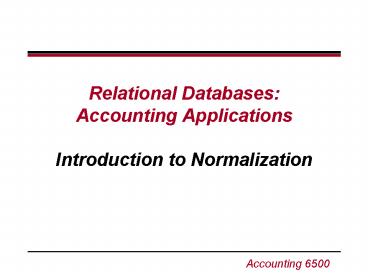Relational Databases: Accounting Applications Introduction to Normalization - PowerPoint PPT Presentation
1 / 25
Title:
Relational Databases: Accounting Applications Introduction to Normalization
Description:
The object of normalization is to arrive at an optimal database structure. ... Types of Database Relationships. One-to-one (Customer ID# --- Customer Name) ... – PowerPoint PPT presentation
Number of Views:55
Avg rating:3.0/5.0
Title: Relational Databases: Accounting Applications Introduction to Normalization
1
Relational DatabasesAccounting
ApplicationsIntroduction to Normalization
2
What is Normalization?
- The object of normalization is to arrive at an
optimal database structure. This optimal
structure will minimize redundancy in the
database. As a result, the integrity of the
information in the database will be protected as
data are added, modified, and deleted.
3
Why Study Normalization?
- Effective use of relational database products
such as MS Access, SQL Server, Oracle, Sybase,
and Informix require knowledge of data
structures. - Relational systems require that data be properly
normalized (i.e. redundancy removed). - Normalization provides a method for
trouble-shooting a database design.
4
What We Will Learn Today About Normalization
- How to recognize a poor data structure
- How to determine why the data structure is
incorrect - How to correct structural errors in the database.
5
Types of Database Relationships
- One-to-one (Customer ID ---gt Customer Name)
- One-to-many (Customer ---gt Invoice)
- Many-to-many (Invoice ltlt---gtgt Products)
6
Example Invoice
7
Prior to Normalization
8
First Normal Form (1NF)
- There is a one-to-one relationship
(correspondence) between the key and the non-key
fields.
9
1NF Violation (Table 1)
- INV
- INV
- DATE
- CUST
- CNAME
- ADDR.
- 11 CAT
- DESC
-
QTY -
PRICE
1M
10
Table 1(a) Repeating Groups Removed
11
Table 2. Repeating Group File
12
Second Normal Form (2NF)
- The table satisfies 1NF and
- All non-key fields are dependent on the whole
key. - (Relevant only for tables with composite keys)
13
2NF Violation (Table 2)
- INV CAT
- DESC
-
QTY -
-
PRICE
14
Table 3. (For fields dependent only on CAT)
15
Table 2(a) Partial Key Dependencies Removed
16
Table 1(a). Revisited (Check 3NF)
17
Third Normal Form
- The table satisfies 1NF and 2NF and
- Non-key fields are dependent only on the key.
18
Alternative Definition of Third Normal Form
- Each non-key field is dependent on the whole
key and nothing but the key.
19
3NF Violation (Table 1(a))
- INV
- DATE
- CUST
-
CNAME -
ADDR.
20
Table 4. Separate File for Customer Data
21
Table 1(b). Non-primary Key Dependencies Removed
22
The Database in 3NF
23
The Database in 3NF
24
Normalization in Class Exercise
- Customer, fname, lname, phone, address,birthday,
rental, rental date, due date, video, copy ,
title, rating, Rental - assume each video number has multiple copies and
each rental is determined by video - Remember can rent more than one video at a time
- Put this information into 3rd normal form
identifying primary keys and foreign keys
25
Practical Steps for getting tables into 3NF
- 1 Divide original table into tables that have
related information - 2 Select candidate key for each table
- 3 Analyze each table and check for
- a 1 NF (no repeating groups--no one to many
relationships from key to any non-key attribute - b 2 NF (1 NF each non-key item dependent on
whole key--applies to composite key tables only - c 3 NF (2 NF remove all transitive
dependencies--non-key field not determine any
other non-key field - 4 If have NF violations, fix by dividing out the
offending fields into another table--divide and
conquer. (May have to iteratively go through
steps 2-4 - 5 Connect tables with appropriate foreign keys































